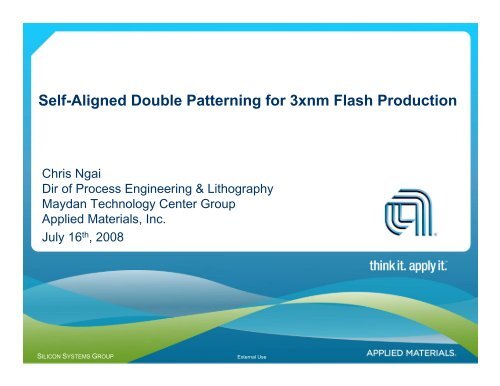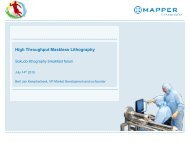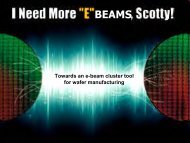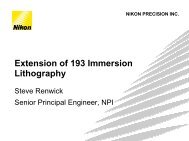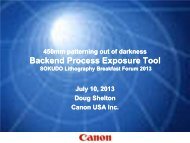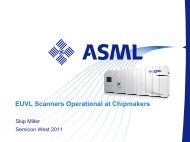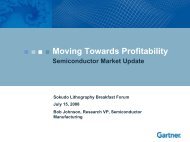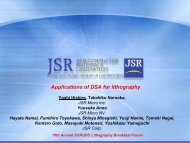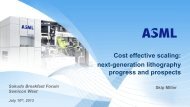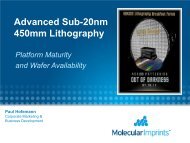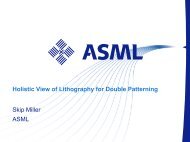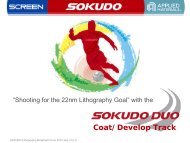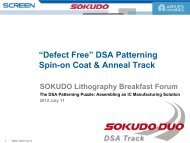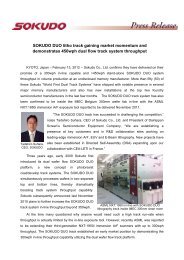Self-Aligned Double Patterning for 3xnm Flash Production - Sokudo
Self-Aligned Double Patterning for 3xnm Flash Production - Sokudo
Self-Aligned Double Patterning for 3xnm Flash Production - Sokudo
You also want an ePaper? Increase the reach of your titles
YUMPU automatically turns print PDFs into web optimized ePapers that Google loves.
<strong>Self</strong>-<strong>Aligned</strong> <strong>Double</strong> <strong>Patterning</strong> <strong>for</strong> <strong>3xnm</strong> <strong>Flash</strong> <strong>Production</strong><br />
Chris Ngai<br />
Dir of Process Engineering & Lithography<br />
Maydan Technology Center Group<br />
Applied Materials, Inc.<br />
July 16 th , 2008<br />
SILICON SYSTEMS GROUP<br />
External Use
Overview<br />
• <strong>Double</strong> <strong>Patterning</strong> Drivers <strong>for</strong> <strong>Flash</strong><br />
• Comparison of <strong>Double</strong> <strong>Patterning</strong> Schemes<br />
• Applied Materials <strong>Self</strong>-aligned <strong>Double</strong> <strong>Patterning</strong> (SADP)<br />
– SADP Approach & 32nm Demonstration<br />
– SADP 22nm Extendibility<br />
– Application Demonstration<br />
– <strong>Production</strong> Proven Products <strong>for</strong> SADP <strong>Flash</strong> Manufacturers<br />
• Summary<br />
2<br />
SILICON SYSTEMS GROUP<br />
External Use
<strong>Double</strong> <strong>Patterning</strong> Drivers<br />
3<br />
SILICON SYSTEMS GROUP<br />
External Use
Drivers <strong>for</strong> SADP<br />
<strong>Flash</strong> - Aggressive half pitch needs<br />
Immersion Lithography – Resolution limitations<br />
<strong>Self</strong>-aligned double patterning (SADP) provides the capability to<br />
achieve aggressive half pitch at relaxed litho conditions<br />
4<br />
SILICON SYSTEMS GROUP<br />
External Use
<strong>Double</strong> <strong>Patterning</strong> Schemes<br />
5<br />
SILICON SYSTEMS GROUP<br />
External Use
<strong>Double</strong> <strong>Patterning</strong> Approaches<br />
Type<br />
<strong>Double</strong> Imaging<br />
<strong>Double</strong> <strong>Patterning</strong><br />
<strong>Self</strong> <strong>Aligned</strong> <strong>Double</strong><br />
<strong>Patterning</strong><br />
1 st Exposure<br />
Resist<br />
BARC<br />
HM<br />
Device<br />
Process Flow<br />
•Coat Expose Develop<br />
•Resist Freeze<br />
•One critical exposure<br />
•Coat Expose Develop<br />
•Spacer Technology<br />
Overlay<br />
(Requirement:<br />
SADP Scheme Comparisons<br />
Process<br />
Scheme<br />
Poly<br />
PR/SOH<br />
APF<br />
Negative<br />
Positive<br />
Positive<br />
Line by Fill<br />
Line by Spacer<br />
Line by Spacer<br />
Metrics<br />
Poly Core<br />
Resist or SOH Core<br />
APF Core<br />
CDU, 3σ<br />
Line/Core/Gap<br />
Good <strong>for</strong> trench<br />
Good <strong>for</strong> line<br />
Good <strong>for</strong> line<br />
1.1 / 1.7 / 2.4nm<br />
LER<br />
Poly ~3.5nm<br />
Same as PR<br />
SADP: Memory Makers’ <strong>Production</strong> Choice<br />
Samsung touts 30nm NAND flash using self-aligned double-patterning<br />
Solid State Technology<br />
October 23, 2007 - Samsung Electronics Co. Ltd. says it has developed 64Gb multilevel cell NAND flash<br />
memory chip using 30nm process technology, built using double-patterning lithography, with commercial<br />
chips ready in about a year.<br />
The new device utilizes a process called "self-aligned double patterning technology" (SaDPT), an<br />
upgrade from charge trap flash that Samsung has used <strong>for</strong> NAND flash on silicon nitride. in SaDPT, the<br />
first pattern transfer is a wider-spaced circuit design of the target process technology, then a second<br />
pattern transfer fills in the spaced area with a more closely designed pattern (see figure).<br />
Samsung says it will use SaDPT with "existing photolithography equipment" <strong>for</strong> production<br />
using the 30nm process technology, targeting commercial production in 2009. In addition to the 64Gb<br />
MLC device, it has also built a 32Gb single-level cell NAND flash chip. Up to 16 64Gb flash devices can<br />
be combined into a 128GB memory card, capable of storing 80 DVD-quality-resolution movies, or 32k<br />
MP3 music files, the company Top said. Story: Lithography is among top productivity challenges<br />
Semiconductor International<br />
November 8, 2007 -- Lithography is among the top productivity challenges facing the semiconductor<br />
industry, but packaging and testing costs are another area that must be addressed, according to Jin<br />
Seog Choi, chief technology officer at Hynix Semiconductor Inc. (Icheon, South Korea).<br />
In a panel presentation at the International Trade Partners Conference (ITPC), held this week in Maui,<br />
Hawaii, Choi addressed the future technologies needed to keep cost reductions on track.<br />
Starting in 2009, when NAND devices are using 30-35 nm design rules and DRAM is in the 43-48 nm<br />
range, the memory manufacturers face critical lithography choices. Extreme ultraviolet (EUV) lithography<br />
offers a low k1 factor, but it is unclear when EUV will be ready <strong>for</strong> high-volume manufacturing. Spacer<br />
patterning technology could be used <strong>for</strong> NAND memories or double patterning lithography may be<br />
required, <strong>for</strong> both DRAM and NAND devices.<br />
However, double patterning “has a high cost of ownership. The low throughput of double patterning is a<br />
key issue,” Choi said…<br />
Major NAND <strong>Flash</strong> Manufacturers have adopted SADP scheme as<br />
the baseline <strong>for</strong> <strong>3xnm</strong> critical layers module development<br />
8<br />
SILICON SYSTEMS GROUP<br />
External Use
32nm and 22nm APF based SADP<br />
APF Properties: Integrity, Alignment<br />
SADP Scheme Per<strong>for</strong>mance, LER<br />
CDU: Line vs Space<br />
9<br />
SILICON SYSTEMS GROUP<br />
External Use
<strong>Self</strong> <strong>Aligned</strong> <strong>Double</strong> <strong>Patterning</strong> Scheme<br />
Print 32nm L&S with 193 dry<br />
Line Edge Roughness<br />
1.5nm<br />
Photoresist<br />
Nitride<br />
32 nm<br />
APF<br />
Oxide<br />
HM<br />
PhotoresistBe<strong>for</strong>e After Trim<br />
Line Edge Roughness:<br />
2.8 3.1nm<br />
48 nm 34 nm<br />
Target<br />
10<br />
SILICON SYSTEMS GROUP<br />
External Use
AMAT 3X SADP Per<strong>for</strong>mance Summary<br />
Core<br />
Gap<br />
Map 1: 92 Die<br />
1 point per die<br />
After Bottom APF Etch<br />
Map 2: 4 full die, 8 partial<br />
25 sub-die locations<br />
Map 3: 9 die<br />
11 locations across array<br />
Wafer left Wafer center Wafer right<br />
B<br />
G<br />
F<br />
C<br />
A<br />
E<br />
H<br />
I<br />
D<br />
Top-view<br />
(Illustrative)<br />
92 die 1 pt<br />
Wafer Edge<br />
Core<br />
(nm)<br />
26.4<br />
27.1<br />
Gap<br />
(nm)<br />
26.5<br />
25.7<br />
Line<br />
(nm)<br />
38.1<br />
38.2<br />
Core-Gap<br />
Delta<br />
(nm)<br />
0.1<br />
-1.4<br />
Within Array 39.0<br />
1.7 1.9<br />
0.9<br />
LER<br />
(nm)<br />
1.4<br />
1.4<br />
LWR<br />
(nm)<br />
1.5<br />
1.3<br />
Core CDU<br />
3σ (nm)<br />
3.1<br />
2.5<br />
Gap CDU<br />
3σ (nm)<br />
2.7<br />
3.2<br />
Line CDU<br />
3σ (nm)<br />
1.1<br />
1.4<br />
• 0.1nm CD difference between core & gap<br />
• CDU
22nm Extendibility<br />
12<br />
SILICON SYSTEMS GROUP<br />
External Use
Summary of AMAT 22nm Spacer Mask Demonstrations:<br />
Core<br />
Gap<br />
22nm Carbon Hardmask<br />
Top-view<br />
Immersion<br />
Litho<br />
Core<br />
Gap<br />
Line<br />
LER Core<br />
LER Gap<br />
Mean (nm)<br />
Slot 16<br />
Slot 25<br />
47.6<br />
47.5<br />
24.1<br />
24.7<br />
22.9<br />
22.7<br />
22.8<br />
22.5<br />
1.6 nm<br />
1.6 nm<br />
1.7 nm<br />
1.5 nm<br />
3σ (nm)<br />
Slot 16<br />
Slot 25<br />
1.8<br />
1.8<br />
1.7<br />
2.0<br />
2.2<br />
2.5<br />
1.8<br />
1.1<br />
*Results from 20 die measurement<br />
Demonstrated extendibility to 22nm<br />
• CD Control of 2nm (3σ)<br />
• LER
Application Demonstration<br />
14<br />
SILICON SYSTEMS GROUP<br />
External Use
Applied Materials SADP Demonstrations<br />
Demonstrated Hardmask <strong>Patterning</strong><br />
32nm APF<br />
22nm APF<br />
34nm <strong>Self</strong> <strong>Aligned</strong> Dense Contact HM<br />
Demonstrated Applications:<br />
Hardmask <strong>for</strong><br />
Contact Holes<br />
32nm TANOS<br />
32nm Oxide<br />
APF<br />
SiO2<br />
32nm STI<br />
22nm Copper Trench<br />
22nm GDR <strong>for</strong> Logic<br />
22nm STI<br />
Demonstrated on <strong>Flash</strong> critical dimension applications<br />
15<br />
SILICON SYSTEMS GROUP<br />
External Use
32nm SADP Process Flow <strong>for</strong> TANOS <strong>Flash</strong><br />
SADP Etch 1 Process<br />
SADP Etch 2 Process<br />
CD Trim Top APF Etch Spacer Etch APF Strip-Out Etch Stop Etch<br />
SADP Etch 2 Process Metal Gate Etch Process HiK Etch Process<br />
Bottom APF Etch<br />
Oxide H.M. Etch<br />
W / WN / TaN<br />
Al2O3 and Si3N4<br />
• AMAT AdvantEdge etch chamber was used <strong>for</strong> all patterning etch steps<br />
• SADP only required 2 etch steps <strong>for</strong> patterning<br />
16<br />
SILICON SYSTEMS GROUP<br />
External Use
Core APF Automatic Process Control (APC) on G5<br />
FF and FB Control ( Litho -> Trimming/BARC/APF Core Etch)<br />
1 2 3<br />
No<br />
control<br />
FF+FB<br />
FF+FB<br />
O 2 Perturbation<br />
• wafers were generated with an<br />
intentional CD variation to<br />
demonstrate FF and FB capability<br />
– Litho CD Range 6.2nm and CD 1σ:<br />
1.49nm<br />
– Target CD is 38nm.<br />
Post etch CD (nm)<br />
FF & FB<br />
FF only<br />
Litho CD (nm)<br />
• Wafers were split into three groups:<br />
• Group 2 and 3:<br />
– Incoming CD 1σ: 1.38nm<br />
– Post etch CD 1σ: 0.57nm<br />
Post etch CD<br />
Wafer<br />
O2 12sccm 15sccm)<br />
Post etch CD w/ no FB (FF only)<br />
Demonstrated WTW CD control of 1.5% of target CD, despite intentional incoming<br />
CD variation and O 2 flow perturbation.<br />
17<br />
SILICON SYSTEMS GROUP<br />
External Use
AMAT SADP Products<br />
18<br />
SILICON SYSTEMS GROUP<br />
External Use
AMAT is ready <strong>for</strong> patterning 32nm & beyond<br />
• Technologies available on proven manufacturing plat<strong>for</strong>ms to reduce<br />
risk and time to market<br />
Producer ® APF<br />
NDP PECVD<br />
AdvantEdge<br />
G5 Etch<br />
UVision ® SP<br />
Brightfield<br />
VeritySEM<br />
Metrology<br />
• Demonstrated Spacer <strong>Self</strong>-Align <strong>Double</strong> <strong>Patterning</strong><br />
– 32nm Lines & Spaces with TANOS Stack, STI, oxide<br />
– 22nm Lines & Spaces with oxide & gridded STI structures<br />
– Achieved:<br />
• LER [
Summary<br />
20<br />
SILICON SYSTEMS GROUP<br />
External Use
SADP: Spacer Mask Approach<br />
APF Core<br />
• Good LER<br />
• Ashable – no wet clean required<br />
• Stable at high temp - spacer temp<br />
requirement relaxed as a result<br />
B<br />
C<br />
NDP Spacer<br />
• >80% step coverage<br />
• Good uni<strong>for</strong>mity<br />
• Good long range micro-loading<br />
per<strong>for</strong>mance<br />
A<br />
G5 <strong>for</strong> all SADP etch steps<br />
• All-in-one chamber <strong>for</strong> all SADP<br />
etch steps & pattern etch<br />
• Good CDU<br />
• High productivity – no warmup<br />
necessary<br />
APF Hardmask<br />
• Good LER of 2nm<br />
• Good line bending resistance<br />
5:1 at 32nm; 4:1 at 22nm<br />
Full Portfolio Of Products Available For SADP Integration Schemes -<br />
Including UVision <strong>for</strong> defect analysis and Verity <strong>for</strong> CD measurement<br />
21<br />
SILICON SYSTEMS GROUP<br />
External Use
22<br />
SILICON SYSTEMS GROUP<br />
External Use


